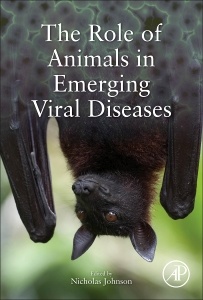Description
The Role of Animals in Emerging Viral Diseases
Coordinator: Johnson Nicholas
Language: English
Subject for The Role of Animals in Emerging Viral Diseases:
Keywords
adaptation; Africa; Animals; Bangladesh; bats; birds; bunyavirus; Canine parvovirus; carnivores; Disease emergence; dog; dogs; Environment; epidemiology; feline panleukopenia virus; foot-and-mouth disease; fox; Genome; Hantavirus; hantavirus disease; hemorrhagic fever with renal syndrome; Hendra virus; Henipavirus; HIV transmission; Human immunodeficiency virus; Lassa fever virus; livestock; Malaysia; Mastomys natalensis; migration; Nigeria; Nipah virus; nucleic acid detection; Paramyxoviridae; Paramyxovirus; polymerase chain reaction; Pteropus; pteropus bats; Rabies virus; raccoon; reservoir hosts; reservoirs; Rift Valley fever virus; rodents; sequencing; microarray; Sierra Leone; simian immunodeficiency virus; Singapore; SIV transmission; Southeast Asia; transferrin receptor type-1; translocation; transmission; vectors; Virus; Virus emergence; virus transmission; West Nile virus; white stork; wildlife; Zoonosis
364 p. · 15x22.8 cm · Hardback
Description
/li>Contents
/li>Readership
/li>Biography
/li>Comment
/li>
The Role of Animals in Emerging Viral Diseases presents what is currently known about the role of animals in the emergence or re-emergence of viruses including HIV-AIDS, SARS, Ebola, avian flu, swine flu, and rabies. It presents the structure, genome, and methods of transmission that influence emergence and considers non-viral factors that favor emergence, such as animal domestication, human demography, population growth, human behavior, and land-use changes.
When viruses jump species, the result can be catastrophic, causing disease and death in humans and animals. These zoonotic outbreaks reflect several factors, including increased mobility of human populations, changes in demography and environmental changes due to globalization. The threat of new, emerging viruses and the fact that there are no vaccines for the most common zoonotic viruses drive research in the biology and ecology of zoonotic transmission.
In this book, specialists in 11 emerging zoonotic viruses present detailed information on each virus's structure, molecular biology, current geographic distribution, and method of transmission. The book discusses the impact of virus emergence by considering the ratio of mortality, morbidity, and asymptomatic infection and assesses methods for predicting, monitoring, mitigating, and controlling viral disease emergence.
virologists, veterinarians, clinicians, infectious disease specialists, researchers, graduate students, post docs.
- Analyzes the structure, molecular biology, current geographic distribution and methods of transmission of 10 viruses
- Provides a clear perspective on how events in wildlife, livestock, and even companion animals have contributed to virus outbreaks and epidemics
- Exemplifies the "one world, one health, one medicine" approach to emerging disease by examining events in animal populations as precursors to what could affect humans

